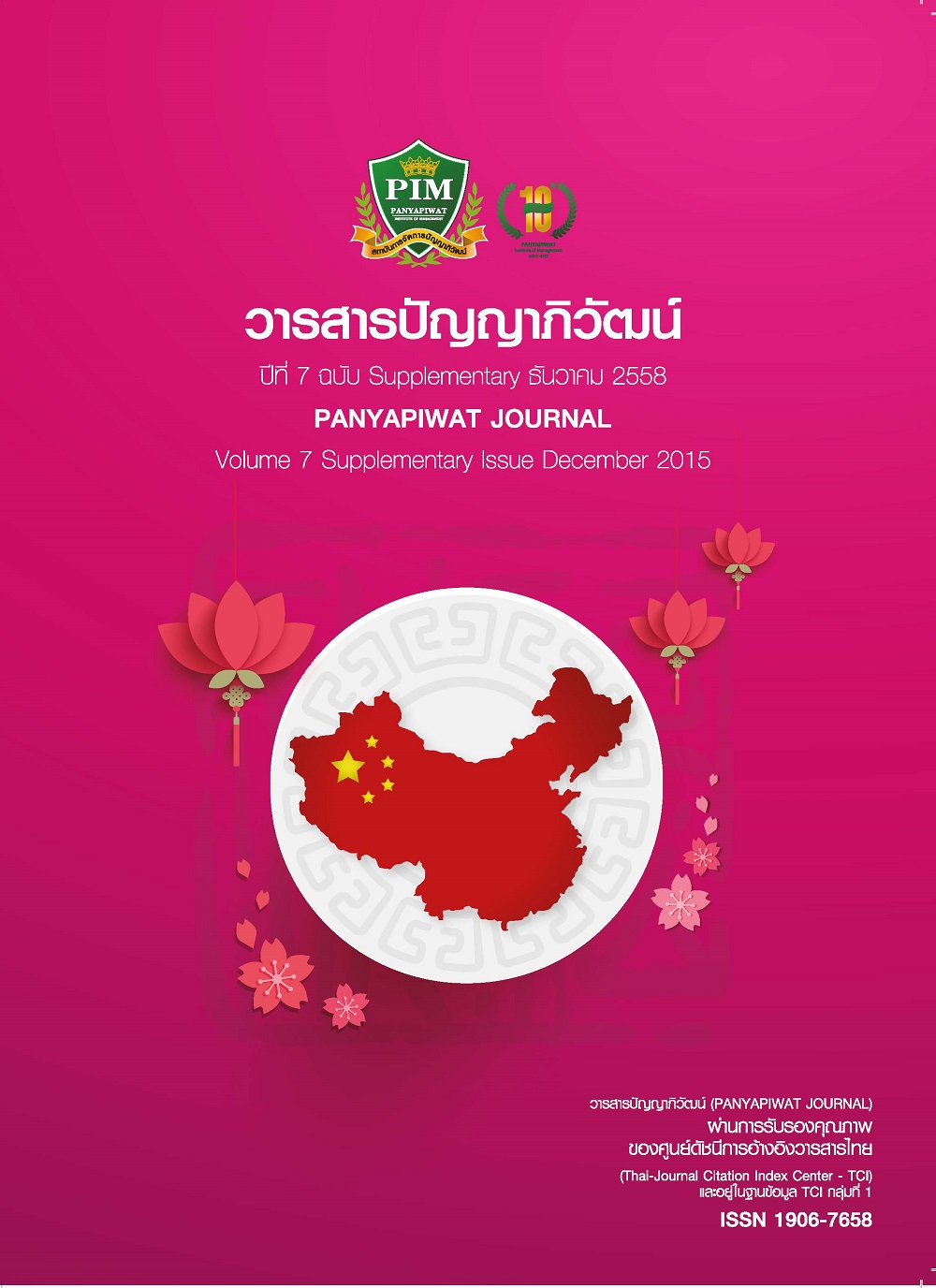ESTIMATING TIME-VARYING SYSTEMATIC RISK BY USING KALMAN FILTERAPPROACH: EVIDENCES FROM THE STOCK EXCHANGE OF THAILAND
Main Article Content
บทคัดย่อ
The objective of this study is focusing on the time-varying systematic risk or beta estimation by using the proper model which can explain the system that varies through time appropriately like Kalman filter model. The motivation of this study comes from requirement of investors and market contributors that wish for the suitable tools to estimate beta properly. Then, this study introduced Kalman filter which is the popular state space model to improve the process of estimation. There were three model specification used in this study which were random walk model, random coefficient model and autoregressive model (AR(1)) model. The results of estimation were compared with static beta from ordinary least squares method. The data applied in this study were the daily return of Thailand Stock Exchange industries group index since January 2007 to June 2014 and there were eight industries group indexes. The results found from the plots of time-varying bet as that three models of Kalman filter can catch up volatility of risk quicker and better than Ordinary least squares. And the most volatile beta among three models of Kalman filter in most of the industries is the form of random coefficient model. Finally, the model were evaluated the performance through root mean square error and mean absolute error calculation, the study found that Kalman filter AR(1) model confirms the superiority in capturing Time-Varying Systematic risk.
วัตถุประสงค์ของการศึกษาในครั้งนี้เป็นการประมาณค่าสัมประสิทธิ์ความเสี่ยงที่เป็นระบบ ซึ่งเปลี่ยนแปลงตามเวลาโดยใช้ตัวแบบ Kalman filter ซึ่งเป็นที่ยอมรับในความสามารถในการอธิบายข้อมูลที่เปลี่ยนแปลงตามเวลาได้อย่างดี ทั้งนี้ความเข้าใจในความเสี่ยงที่เป็นระบบอย่างถูกต้องเป็นประโยชน์อย่างยิ่งกับนักลงทุน เพื่อที่จะตอบสนองกับความผันผวนของตลาดทุนได้อย่างรวดเร็ว ดังนั้นวิธีในการประมาณค่าที่เหมาะสมจึงเป็นเครื่องมือทางการเงินที่สำคัญของนักลงทุน การศึกษาในครั้งนี้จึงมุ่งเน้นที่การใช้ตัวแบบ Kalman filter ในการพัฒนาการประมาณค่าสัมประสิทธิ์ความเสี่ยงที่เป็นระบบให้ถูกต้องมากขึ้น โดยตัวแบบ Kalman filter ที่ใช้มีทั้งหมด 3 ตัวแบบ ได้แก่ ตัวแบบ Random walk ตัวแบบ Random coefficient และตัวแบบ Autoregressive (AR(1)) โดยผลการประมาณค่าโดยตัวแบบทั้ง 3 นี้จะนำมาเปรียบเทียบกับผลการประมาณค่าสัมประสิทธิ์ความเสี่ยงที่เป็นระบบโดยวิธีการวิเคราะห์การถดถอยแบบ OLS ข้อมูลที่ใช้ในการศึกษาในครั้งนี้เป็นข้อมูลผลตอบแทนรายวันจาก ดัชนีกลุ่มอุตสาหกรรมต่างๆ ตามตลาดหลักทรัพย์แห่งประเทศไทย ประกอบไปด้วย 8 กลุ่มอุตสาหกรรม และใช้ข้อมูลรายวันตั้งแต่ มกราคม พ.ศ.2550 ถึงมิถุนายน พ.ศ.2557 จากผลการศึกษาโดยการสร้างแผนภาพพบว่า ตัวแบบของ Kalman filter ทั้ง 3 แบบสามารถแสดงให้เห็นถึงความผันผวนของตลาดได้รวดเร็วและดีกว่า ตัวแบบการวิเคราะห์การถดถอยแบบ OLS และตัวแบบที่ให้ค่าสัมประสิทธิ์ความเสี่ยงที่เป็นระบบผันผวนที่สุด คือ ตัวแบบ Random coefficient ซึ่งให้ผลสอดคล้องกันในกลุ่มดัชนีอุตสาหกรรมส่วนใหญ่ ในส่วนสุดท้าย การศึกษาในครั้งนี้ได้ทำการประเมินความสามารถของตัวแบบโดยคำนวณรากที่สองของควาคลาดเคลื่อนกำลังสองเฉลี่ย (root mean square error; RMSE) และความคลาดเคลื่อนสัมบูรณ์เฉลี่ย (mean absolute error; MAE) ผลการศึกษาพบว่า ตัวแบบ Kalman filter AR(1) เป็นตัวแบบที่ให้ผลการประมาณค่าสัมประสิทธิ์ความเสี่ยงที่เป็นระบบ ซึ่งเปลี่ยนแปลงตามเวลาได้ดีกว่าตัวแบบอื่นในการศึกษาในครั้งนี้
Article Details
“ข้าพเจ้าและผู้เขียนร่วม (ถ้ามี) ขอรับรองว่า บทความที่เสนอมานี้ยังไม่เคยได้รับการตีพิมพ์และไม่ได้อยู่ระหว่างกระบวนการพิจารณาลงตีพิมพ์ในวารสารหรือแหล่งเผยแพร่อื่นใด ข้าพเจ้าและผู้เขียนร่วมยอมรับหลักเกณฑ์การพิจารณาต้นฉบับ ทั้งยินยอมให้กองบรรณาธิการมีสิทธิ์พิจารณาและตรวจแก้ต้นฉบับได้ตามที่เห็นสมควร พร้อมนี้ขอมอบลิขสิทธิ์บทความที่ได้รับการตีพิมพ์ให้แก่สถาบันการจัดการปัญญาภิวัฒน์หากมีการฟ้องร้องเรื่องการละเมิดลิขสิทธิ์เกี่ยวกับภาพ กราฟ ข้อความส่วนใดส่วนหนึ่งและ/หรือข้อคิดเห็นที่ปรากฏในบทความข้าพเจ้าและผู้เขียนร่วมยินยอมรับผิดชอบแต่เพียงฝ่ายเดียว”
References
Bey, R. & Pinches, G. (1980). Additional evidence of heteroskedasticity in the market model.Journal of Financial and Quantitative Analysis, 15(2), 299-322.
Black, F. (1972). Capital market equilibrium with restricted borrowing. Journal of Business, 45(3),445-455.
Bollerslev, T., Engle, R. F. & Wooldrige J. M. (1988). A Capital Asset Pricing Model with Time-varying Covariance. Journal of Political Economy, 96, 116-131.
Bos, T. & Newbold, P. (1984). An empirical investigation of possibility of stochastic systematic risk in the market. Journal of Business, 57(1), 35-41.
Campbell, J. Y. & Vuolteenaho, T. (2004). Bad beta, Good Beta. American Economic Review, 94(5), 1249-1275.
Choudhry, T. & Wu, H. (2007). Forecasting the weekly time-varying beta of UK firms: GARCH models
vs. Kalman filter method.
Collins, D. W., Ledolter, J. & Rayburn, J. (1987). Some further evidence on the stochastic properties of systematic risk. Journal of Business, 60(3), 425-448.
Ender, W. (2004). Applied Econometric Time Series. (31° ed.). Hoboken: John Wiley and Sons.
Fabozzi, F. & Francis, J. (1978). Beta as a Random Coefficient Journal of Financial and Quantitative Analysis, 13, 101-116.
Faff, R. W., Hillier, D. & Hillier, J. (2000). Time varying beta risk: an analysis of alternative modeling techniques. Journal of Business Finance and Accounting, 27, 523-554.
Fama, E. F. & French, K. R. (1997). Industry costs of equity. Journal of Financial Economics, 43(2), 153-193.
Ferson, W. E. & Harvey, C. R. (1999). Conditioning Variables and the Cross Section of Stock Returns. Journal of Finance, 54(4), 1325-1360.
Grundy, K. & Malkiel, B. G. (1996). Reports of beta's death have been greatly exaggerated. Journal of Portfolio Management, 22(3), 36-44.
Harvey, A. C., Ruiz, E. & Sentana, E. (1992). Unobserved component time series models with arch disturbances. The Journal of Econometrics, 52(1-2), 341-349
Lintner, J. (1965). The valuation of risk y assets and the selection of risky investments in stock portfolios and capital budgets. Review of Economics and Statistics, 47, 13-37.
Mergner, S. & Bulla, J. (2008). Time-varying beta risk of Pan-European industry portfolios: A comparison of alternative modeling techniques. The European Journal of Finance, 14(8), 771-802.
Moonis, S. A. & Shah, A. (2003). Testing for time-variation in beta in India. Journal of Emerging Market Finance, 2(2), 163-180.
Mossin, J. (1966). Equilibrium in a capital asset market. Econometrica, 34(4), 768-783.
Nieto, B., Orbe, S. & Zarraga, A. (2014). Time-varying market beta: does the estimation methodology matter?. Statistics and Operations Research Transactions, 38(1), 13-24.
Sharpe, W. (1965). Capital asset pricing: a theory of market equilibrium under conditions of risk. Journal of Finance, 19, 425-442.
Tse, Y. K. & Tsui, A. K. C. (2002). A Multivariate GARCH Model with Time-varying Correlations.Journal of Business & Economic Statistics, 20(3), 351-362.
Wealch, G. & Bishop, G. (2006). An Introduction to the Kalman Filter. University of North Carolina at Chapel Hill, Department of Computer Science, Retrieved Jan 30, 2014, from http://www.cs.unc.edu/~welch/media/pdf/kalman_intro.pdf
Wells, C. (1994). Variable betas on the Stockholm exchange 1971-1989. Applied Financial Economics,4(1), 75-92.

